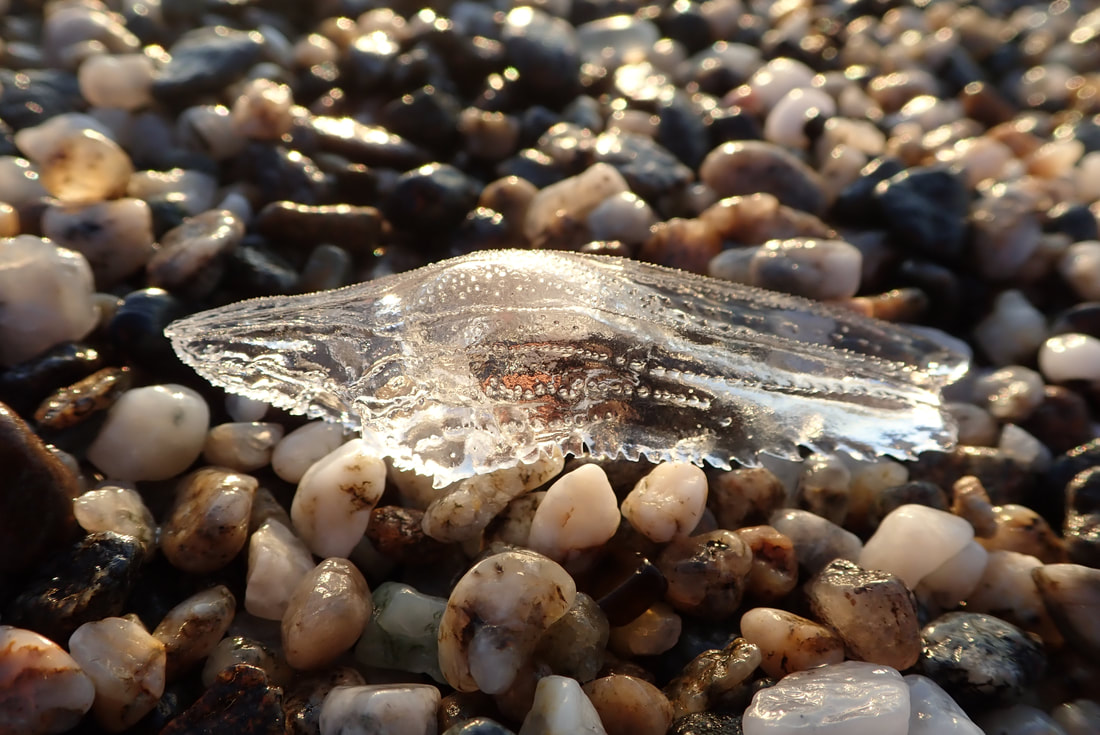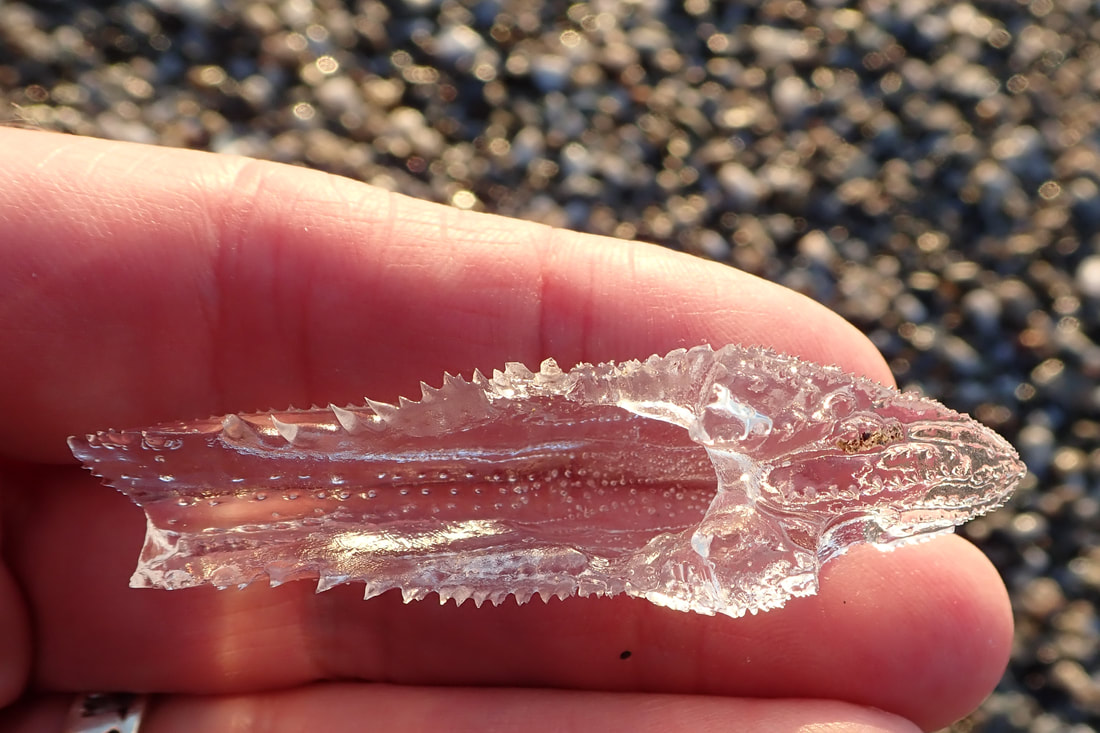Scarpetta di cristallo, a pseudoconch of the Pteropod, Cymbulia peronii, Sicily, 19th April 2022
“This is a very remarkable, though incompletely known, genus of animals of the order Pterodibranches, in the class of Cephalophores molluscs, established by MM. Péron and Lesueur for an animal they found in the Mediterranean, on the coast of Nice” - Blainville 1818.
I came across this firm, gelatinous pseudoconch whilst walking along a beach in north-east Sicily. But my first thought as I bent to pick it up, was that perhaps it was the remains of a lure used by local fisherman, punched out of some industrial mould in China. Roughly, 6cm in length and looking like a little slipper there might equally have been some Cinderella-of-the-sea, wondering what became of her shoe.
These idle holiday thoughts were quickly enough dispelled when I used Google Lens to search for similar images online and saw very quickly that what I had found was the remains of a Pteropod, most likely Cymbulia peronii Blainville, 1818. Images available for the species on MolluscaBase reinforced this identification (MolluscaBase 2022).
Before travelling to Sicily I had downloaded the iNaturalist app in anticipation of doing a little biological recording whilst there and the following day I submitted a record of the find using the app on my phone. This turned out to be the first record of the species entered into iNaturalist for Sicily. Though interestingly, a second record from someone else, was then entered at the beginning of May though they had found their specimen a month previous to mine.
Molluscs in the Order Pteropoda are thought to do well in Spring and as such abundances can peak at this time (Wikipedia contributors, 2022). This may help to explain, in part, my good fortune in coming across this specimen. Given that the species, when living, has a reported depth range of between 150 and 2000m I feel doubly lucky to have found it (GBIF Secretariat, 2021)!
Pteropod derives from the Greek and means “wing-foot”. C. peronii has several common names. In the eighteenth century French fishermen referred to it as “papillon de mer” and this led to the English term “sea butterfly”. Very apt for the living animal as the foot of this snail has formed wide, wing-like, flaps which enable it to ‘fly’ through the water. An Italian name captures the appearance of the species based on the pseudoconch, which is perhaps appropriate given that most of us will never see one live in the water, “Scarpetta di cristallo” or, “crystal slipper”.
According to the Checklist of Phylum Mollusca there are four species of Cymbuliidae found in the Mediterranean (Templado and Villanueva, 2010):
Cymbulia parvidentata Pelseneer, 1888
Cymbulia peronii Blainville, 1827
Corolla spectabilis Dall, 1871
Gleba cordata Niebuhr, 1776
At 4.5cm the pseudoconch of G. cordata is smaller than C. peronii and shaped differently being more rounded and simply covered with a few warts (Naturalis Biodiversity Centre, 2022a). Similarly, the pseudoconch of C. spectabilis is up to 4cm long with a broadly oval shape and covered in large warts (Naturalis Biodiversity Centre, 2022b). That leaves C. parvidentata which does have a similar slipper-like shape to C. peronii but is smaller at 3.5cm and is pinched, or laterally compressed in the middle (Naturalis Biodiversity Centre, 2022c). Note too, the distinct spines arranged in rows, which cover C. peronii. Some are quite large, and others irregularly distributed between the rows.
The species was chosen as one of the five ‘Molluscs of the Year 2022’ by the LOEWE Centre for Translational Biodiversity Genomics. It did not win but was selected in part because sea butterflies are considered “canaries in the coal mine” with regard to ocean acidification.
I came across this firm, gelatinous pseudoconch whilst walking along a beach in north-east Sicily. But my first thought as I bent to pick it up, was that perhaps it was the remains of a lure used by local fisherman, punched out of some industrial mould in China. Roughly, 6cm in length and looking like a little slipper there might equally have been some Cinderella-of-the-sea, wondering what became of her shoe.
These idle holiday thoughts were quickly enough dispelled when I used Google Lens to search for similar images online and saw very quickly that what I had found was the remains of a Pteropod, most likely Cymbulia peronii Blainville, 1818. Images available for the species on MolluscaBase reinforced this identification (MolluscaBase 2022).
Before travelling to Sicily I had downloaded the iNaturalist app in anticipation of doing a little biological recording whilst there and the following day I submitted a record of the find using the app on my phone. This turned out to be the first record of the species entered into iNaturalist for Sicily. Though interestingly, a second record from someone else, was then entered at the beginning of May though they had found their specimen a month previous to mine.
Molluscs in the Order Pteropoda are thought to do well in Spring and as such abundances can peak at this time (Wikipedia contributors, 2022). This may help to explain, in part, my good fortune in coming across this specimen. Given that the species, when living, has a reported depth range of between 150 and 2000m I feel doubly lucky to have found it (GBIF Secretariat, 2021)!
Pteropod derives from the Greek and means “wing-foot”. C. peronii has several common names. In the eighteenth century French fishermen referred to it as “papillon de mer” and this led to the English term “sea butterfly”. Very apt for the living animal as the foot of this snail has formed wide, wing-like, flaps which enable it to ‘fly’ through the water. An Italian name captures the appearance of the species based on the pseudoconch, which is perhaps appropriate given that most of us will never see one live in the water, “Scarpetta di cristallo” or, “crystal slipper”.
According to the Checklist of Phylum Mollusca there are four species of Cymbuliidae found in the Mediterranean (Templado and Villanueva, 2010):
Cymbulia parvidentata Pelseneer, 1888
Cymbulia peronii Blainville, 1827
Corolla spectabilis Dall, 1871
Gleba cordata Niebuhr, 1776
At 4.5cm the pseudoconch of G. cordata is smaller than C. peronii and shaped differently being more rounded and simply covered with a few warts (Naturalis Biodiversity Centre, 2022a). Similarly, the pseudoconch of C. spectabilis is up to 4cm long with a broadly oval shape and covered in large warts (Naturalis Biodiversity Centre, 2022b). That leaves C. parvidentata which does have a similar slipper-like shape to C. peronii but is smaller at 3.5cm and is pinched, or laterally compressed in the middle (Naturalis Biodiversity Centre, 2022c). Note too, the distinct spines arranged in rows, which cover C. peronii. Some are quite large, and others irregularly distributed between the rows.
The species was chosen as one of the five ‘Molluscs of the Year 2022’ by the LOEWE Centre for Translational Biodiversity Genomics. It did not win but was selected in part because sea butterflies are considered “canaries in the coal mine” with regard to ocean acidification.
References
Blainville, H. M. D. de. (1818). Cymbulie, Cymbulia, pp. 332-333, in: Dictionnaire des Sciences Naturelles (F. Cuvier, ed.), vol. 12. Levrault, Strasbourg & Paris, & Le Normant, Paris. , available online at http://www.biodiversitylibrary.org/page/23002013
GBIF Secretariat (2021). Cymbulia peronii f. peronii Blainville, 1818 (https://www.gbif.org/species/7642027). GBIF Backbone Taxonomy. Checklist dataset https://doi.org/10.15468/39omei accessed via GBIF.org on 2022-05-18.
MolluscaBase eds. (2022). MolluscaBase. Cymbulia peronii Blainville, 1818. Accessed at: https://www.molluscabase.org/aphia.php?p=taxdetails&id=139494 on 2022-05-18
Naturalis Biodiversity Centre (2022a). Gleba cordata. In Pelagic Molluscs 2.0. Accessed at: https://pelagic-molluscs.linnaeus.naturalis.nl/linnaeus_ng/app/views/species/taxon.php?id=116770 on 2022-05-18
Naturalis Biodiversity Centre (2022b). Corolla spectabilis. In Pelagic Molluscs 2.0. Accessed at: https://pelagic-molluscs.linnaeus.naturalis.nl/linnaeus_ng/app/views/species/taxon.php?id=116768 on 2022-05-18
Naturalis Biodiversity Centre (2022c). Cymbulia parvidentata. In Pelagic Molluscs 2.0. Accessed at: https://pelagic-molluscs.linnaeus.naturalis.nl/linnaeus_ng/app/views/species/taxon.php?id=116764 on 2022-05-18
Templado, J. and Villanueva, R. (2010). Checklist of Phylum Mollusca. pp. 148-198 In Coll, M., et al., 2010. The biodiversity of the Mediterranean Sea: estimates, patterns, and threats. PLoS ONE 5(8):36pp.
Wikipedia contributors. (2022, March 15). Pteropoda. In Wikipedia, The Free Encyclopedia. Retrieved 15:16, May 18, 2022, from https://en.wikipedia.org/w/index.php?title=Pteropoda&oldid=1077338032
Blainville, H. M. D. de. (1818). Cymbulie, Cymbulia, pp. 332-333, in: Dictionnaire des Sciences Naturelles (F. Cuvier, ed.), vol. 12. Levrault, Strasbourg & Paris, & Le Normant, Paris. , available online at http://www.biodiversitylibrary.org/page/23002013
GBIF Secretariat (2021). Cymbulia peronii f. peronii Blainville, 1818 (https://www.gbif.org/species/7642027). GBIF Backbone Taxonomy. Checklist dataset https://doi.org/10.15468/39omei accessed via GBIF.org on 2022-05-18.
MolluscaBase eds. (2022). MolluscaBase. Cymbulia peronii Blainville, 1818. Accessed at: https://www.molluscabase.org/aphia.php?p=taxdetails&id=139494 on 2022-05-18
Naturalis Biodiversity Centre (2022a). Gleba cordata. In Pelagic Molluscs 2.0. Accessed at: https://pelagic-molluscs.linnaeus.naturalis.nl/linnaeus_ng/app/views/species/taxon.php?id=116770 on 2022-05-18
Naturalis Biodiversity Centre (2022b). Corolla spectabilis. In Pelagic Molluscs 2.0. Accessed at: https://pelagic-molluscs.linnaeus.naturalis.nl/linnaeus_ng/app/views/species/taxon.php?id=116768 on 2022-05-18
Naturalis Biodiversity Centre (2022c). Cymbulia parvidentata. In Pelagic Molluscs 2.0. Accessed at: https://pelagic-molluscs.linnaeus.naturalis.nl/linnaeus_ng/app/views/species/taxon.php?id=116764 on 2022-05-18
Templado, J. and Villanueva, R. (2010). Checklist of Phylum Mollusca. pp. 148-198 In Coll, M., et al., 2010. The biodiversity of the Mediterranean Sea: estimates, patterns, and threats. PLoS ONE 5(8):36pp.
Wikipedia contributors. (2022, March 15). Pteropoda. In Wikipedia, The Free Encyclopedia. Retrieved 15:16, May 18, 2022, from https://en.wikipedia.org/w/index.php?title=Pteropoda&oldid=1077338032
Citation: This article was originally published in the Summer 2022 issue of Mollusc World and can be cited as follows:
Barfield, P. D. (2022). Scarpetta di cristallo, a pseudoconch of the Pteropod, Cymbulia peronii, Sicily, 19th April 2022. Mollusc World, No. 59, 29. ISSN 1740-1070.
Barfield, P. D. (2022). Scarpetta di cristallo, a pseudoconch of the Pteropod, Cymbulia peronii, Sicily, 19th April 2022. Mollusc World, No. 59, 29. ISSN 1740-1070.
| mollusc_world_issue_59_july_2022_cymbulia_peronii.pdf |

